My shopping cart
Your cart is currently empty.
Continue Shopping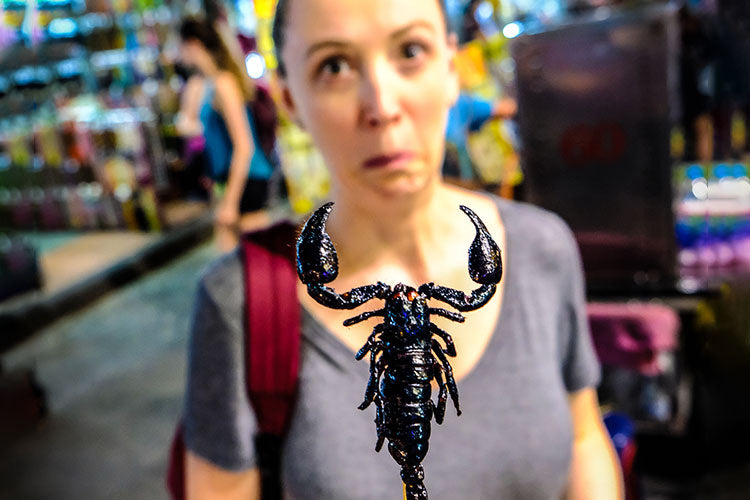
People around the world fall in love with Thai food like Massaman Curry, Pad Thai, Tom Yam or Som Tam and often hear about common ingredients such as hot chili peppers, lemongrass, holy basil, coconut milk, and fish sauce. However, there is more to Thailand’s culinary scene than Tom Yam and curries. You might be surprised to see that Thai people use many ‘out of the ordinary’ ingredients to cook amazing and delicious dishes. Here are some unusual Thai dishes and ingredients that you may have never heard of, but if you have a chance to try it you may never forget.

Khao Chae is a summer delicacy, meaning "rice soaked in cool water". "Khao" means "rice" and "chae" means "to soak". It is believed to have originated in the Mon community and later made famous in the Thai royal court.
Traditionally the dish is prepared by soaking cooked jasmine rice in the ice-cold water scented naturally with jasmine or chommanad flowers. The rice is served with several side dishes such as Luk Kapi (fried shrimp paste balls), Phrik Yuak Sord Sai (steamed stuffed bell pepper with minced chicken and shrimp), Pla Chon Hang (sweet shredded fish), Hom Daeng Yud Sai (fried stuffed shallots with ground catfish), Moo Foi (deep-fried sweet pork strips), and Chai Pow Pad Kai (stir-fried sweet radish with egg).
Preparing Khao Chae is quite complicated and takes time, so it is not a common dish you can find anywhere at any time in Thailand. But some traditional Thai restaurants offer this delicacy as part of their summer menu.

Stink beans, officially known as parkia speciosa, or Sataw in Thai are a popular ingredient in the Southern Thailand cuisine, widely used in curries and stir-fried dishes .
Stink beans have a bit of a strong taste and aroma and usually add a bitter, nutty profile to the food. A classic and popular dish is Goong Pad Sataw (Stir Fried Stink Beans with shrimp) made by stir-fry fresh shrimp with Sataw, red chili paste and seasoned with fish sauce and coconut sugar. You can also add a bit of coconut milk to make it creamier and tone down the spiciness.
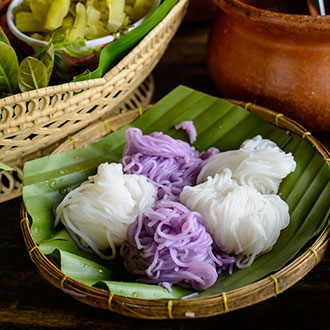
Khanom Jeen are fresh, thin rice noodles used in Thai cuisine. They are made from fermented rice (typically fermented for three days), boiled, and then made into noodles by extruding the resulting dough through a sieve into boiling water.
Khanom Jeen is served in many kinds of stock: coconut milk, fish curry, and chilli. The way to eat Khanom Jeen is to top it with curries - most curries are fine with the noodles, but popular ones are green curry chicken, fish curry and sweet chilli paste.
It can be eated together with any vegetables like long beans, pickled mustard greens, shredded cabbage, sprouts, Thai basil leaves and pickled vegetables.
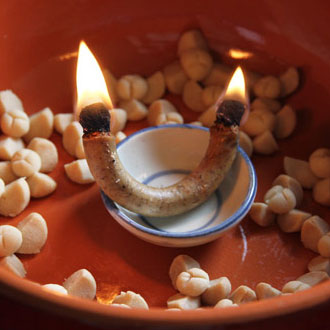
Tian Op is a traditional Thai fragranced candle, used for perfuming food, primarily sweets and desserts, for the purpose of adding a unique aroma to the dish.
Traditional Tian op is made from frankincense, ylang-ylang and patchouli, lending the musky scent of warm honey, wood and spiced fruit to the desserts. The chefs use the horseshoe-shaped candle by lighting both ends of it and wafting the smoke to perfume the food.
The candle is used mostly in traditional Thai sweets and desserts like Kleeb Lamduan cookies (Thai shortbread cookies), Salim with coconut milk (Sweet noodles in coconut milk), Thong Ek (Wheat Flour Dumplings with Egg Yolks), or Sam Pan Nee (Thai Melting-Moment Cookies).

The use of insects as food (or entomophagy) has long been common practice in Thailand, especially in some parts of the country like the Northeast where meat used to be in low supply in the past, insects were their second protein resource. Insects are low in calories, high in protein and extremely nutritious.
Most popular insects used for food include grasshoppers, giant water bugs, crickets, silk worms, bamboo worms, and scorpion. They are all prepared in a very similar fashion, deep fried to a crisp and nicely salted.
Ant Larvae or ant eggs are a delicacy in Isan cuisine, where it is used in a spicy salad, soup or added to omelettes. They are clean and high in protein and contain acetic acid so they taste almost like a squirt of lime and are fatty and sweet.
They have a delicate taste, soft appealing texture and a slightly tart edge. Ant Larvae is a very versatile food whether eaten on their own or as an ingredient in recipes. Some popular dishes are Kai Jiaw Kai Mod (ant egg omelettes), Gaeng Kai Mod Daeng (ant egg soup) and Koi Kai Mod Daeng or Yam Kai Mod Deang (Spicy Raw Ant Egg Salad). The ant eggs can only be collected in the dry season between March and May so it can cost about three times as much as regular meat like chicken or pork. You can find this delicacy in some Isan restaurants serving them as special menu during summer time.
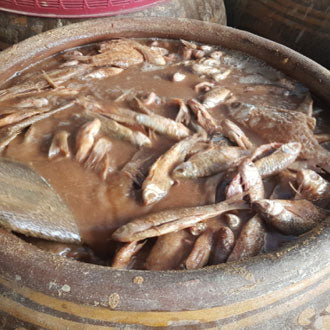
Pla Ra is a traditional Thai seasoning produced by fermenting fish with rice bran or roasted rice flour and salt fermented in a closed container for at least six months.
It is widely used in Isan cuisine, especially with Som Tam Salad and spicy dips. Sometimes the liquid is used in place of fish sauce because of its salty flavor. However, Pla ra isn't for everyone because it has a very strong smell, it can be unpleasant even for some Thai people. But if you try and develop a taste for it, there’s no going back.

Santol is called Kraton in Thailand. In English it is referred to as a wide mangosteen or cotton fruit. The fruit has a thick yellow skin when split open to reveal cottony white pulp in seed segments like mangosteen.
Santol is used for cooking main dishes and desserts like Tam Kraton (spicy santol salad), Keang Kua Kai Kraton (red curry with chicken and santol) or macerated in syrup and eaten with shaved ice.
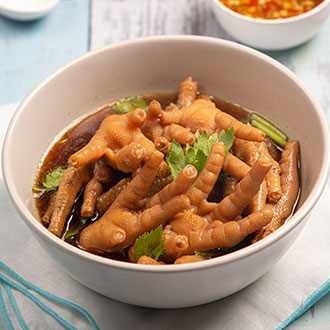
Eating chicken feet (or Teen Gai in Thai) is common in Asia, and there are many ways to enjoy them. In Thailand, they usually prepare the feet by removing the out part and clean them thoroughly.
Then often braised, deep-fried or boil them in a spicy and sour broth similar to Tom Yam. They taste like other parts of the chicken, except different in texture.
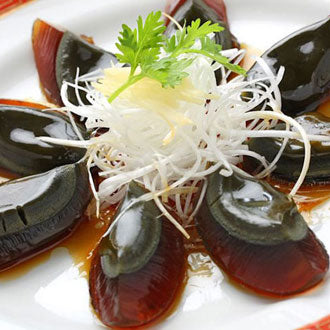
Kai Yeow Ma, or Century egg, are basically blackened eggs that are preserved for months in a mix of ingredients like salt, lime, and ash. Due to the preservation method, the egg becomes dark in colour and has creamy consistency, but it takes on a strange aroma as well. However, they are mellow when cooked and the creamy texture of the egg is quite satisfying. Thais usually use the egg in spicy salad and sir-fried dishes.